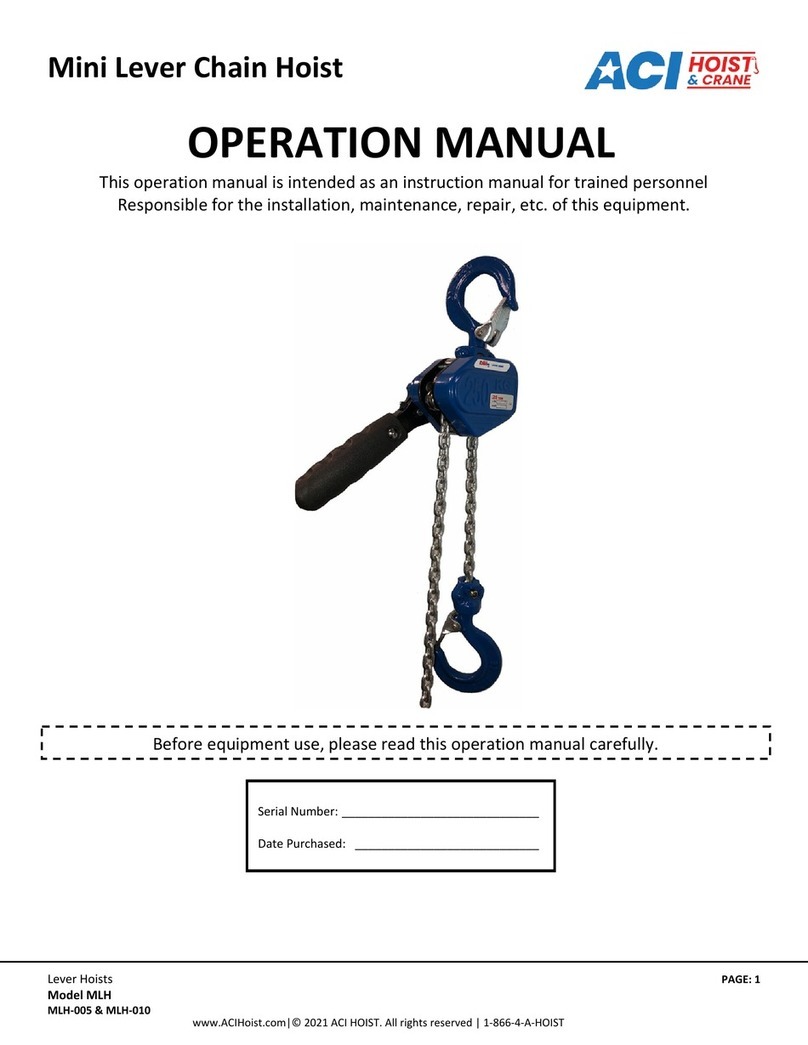
Mechanics Hoists PAGE: 3
Model MH MH-0214
2721 NE 4th Ave Pompano FL 33064| (954) 367-6116 Visit WWW.ACIHOIST.COM for the most current information
TABLE OF CONTENTS
1.0 WARRANTY .............................................................................................................................................................. 5
2.0 SAFETY PRECAUTIONS........................................................................................................................................... 6
2.1 Safety Alert Symbols...................................................................................................................................... 6
3.0 INSTALLATION......................................................................................................................................................... 7
3.1 Unpacking ..................................................................................................................................................... 7
3.2 Pre-installation Checks .................................................................................................................................. 7
3.3 Power Supply System.................................................................................................................................... 7
3.4 Connection to the Electrical Supply ............................................................................................................... 8
3.5 Mounting the Hoist ........................................................................................................................................ 8
3.6 Hook and Eye Suspension Hoists.................................................................................................................. 8
3.7 Load Chain.................................................................................................................................................... 8
3.8 Load Chain Lubrication.................................................................................................................................. 8
3.9 Chain Container............................................................................................................................................. 9
3.9.1 Installation of Standard Chain Container.......................................................................................... 9
4.0 OPERATION............................................................................................................................................................ 10
4.1 Test and Operational Checks........................................................................................................................10
4.2 Operation Personnel.....................................................................................................................................11
4.3 Product Warnings .........................................................................................................................................11
4.4 Product Cautions..........................................................................................................................................12
5.0 INSPECTION........................................................................................................................................................... 14
5.1 General.........................................................................................................................................................14
5.2 Inspection Classification ...............................................................................................................................14
5.3 Frequent Inspection......................................................................................................................................15
5.4 Periodic Inspection .......................................................................................................................................15
5.5 Occasionally Used Hoist...............................................................................................................................16
5.6 Inspection Reports........................................................................................................................................16
5.7 Inspection Methods and Criteria ...................................................................................................................16
5.8 Chain Inspection...........................................................................................................................................18
6.0 MAINTENANCE AND REPAIR................................................................................................................................ 19
6.1 Cutting the Chain..........................................................................................................................................19
6.2 Lubrication....................................................................................................................................................19
6.3 Replacing Gear Brakes & Oil.........................................................................................................................20
6.4 Testing .........................................................................................................................................................21
7.0 TROUBLESHOOTING............................................................................................................................................. 22
8.0 WIRING DIAGRAM ................................................................................................................................................. 23
9.0 DIMENSIONS & SPECIFICATIONS........................................................................................................................ 24
10.0 EXPLODED VIEWS & PARTS LISTS..................................................................................................................... 26






























